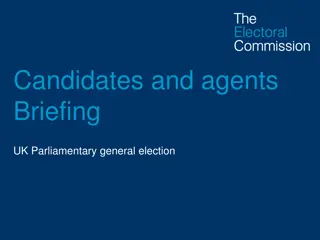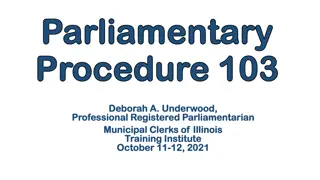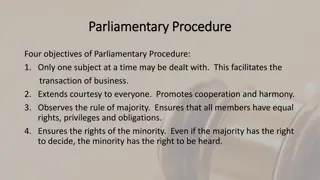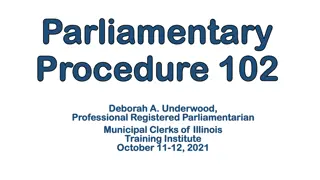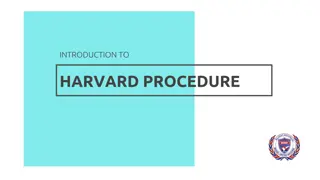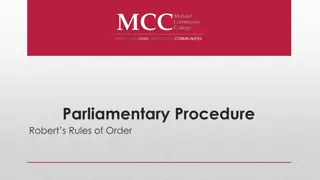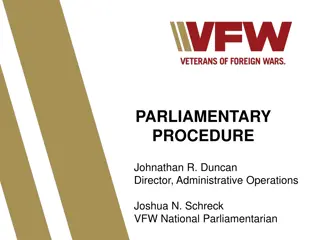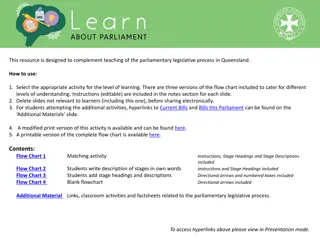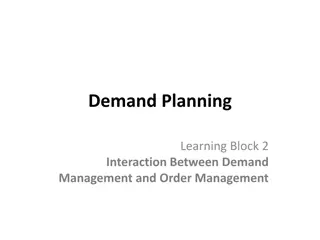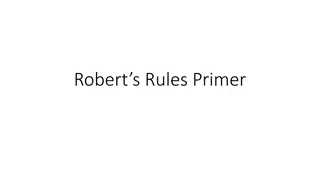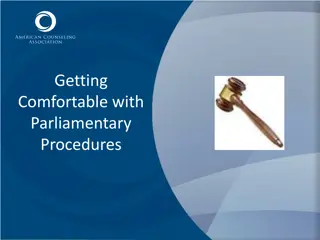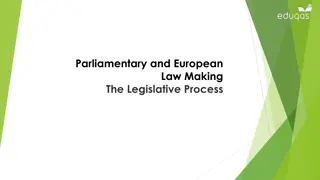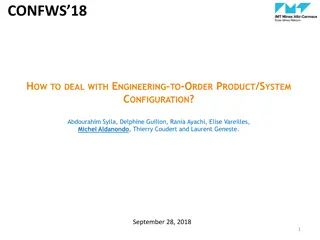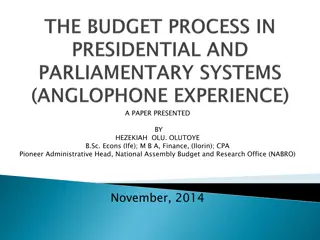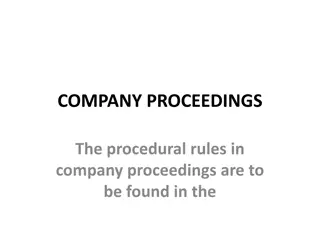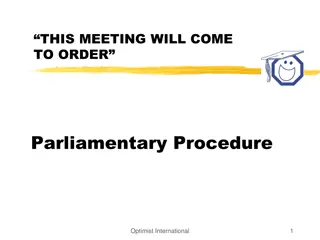Understanding Parliamentary Basics and the Purpose of Roberts Rules of Order
This content details the basics of parliamentary procedures, focusing on the purpose of Roberts Rules of Order in running meetings uniformly, facilitating business transactions, and protecting the rights of all members. It also highlights the hierarchy of rules, general rules of Robert, and the history and overview of the House of Delegates.
Download Presentation

Please find below an Image/Link to download the presentation.
The content on the website is provided AS IS for your information and personal use only. It may not be sold, licensed, or shared on other websites without obtaining consent from the author. Download presentation by click this link. If you encounter any issues during the download, it is possible that the publisher has removed the file from their server.
E N D
Presentation Transcript
Parliamentary Basics Pennsylvania Bar Association House of Delegates
Purpose of Roberts Rules of Order (RONR)
Purpose To run meetings uniformly, regardless of where the meeting is held. To facilitate the transaction of business and promote cooperation. To insert logic and common sense into the operation of a meeting. To protect the rights of all members of the body.
The Rules Protect The rights of the majority to decide an issue. The rights of the minority to be heard on an issue. The rights of the individual members. The rights of the absent.
Federal, state, and local laws Articles of Incorporation/Corporate Charter Bylaws Special rules of order Parliamentary authority Standing rules Custom Typical rules follow this hierarchy Robert s Rules of Order, 12th Edition (RONR)
General Rules of Robert All members have equal rights, privileges, and obligations. Only one question can be considered at any given time. Members always have the right to know what question is pending and to have it stated on the record again before a vote is taken.
General Rules of Robert No member can speak until recognized by the chair. No person can speak a second time on the same question without consent of the House. The chair shall be impartial.
Overview of the House
History of the House The House of Delegates, created in 1966, is the body charged with setting the policy of PBA. All voting rights of PBA members are exercised through the House, including the right to vote on matters affecting the substance and administration of PBA policy, and on amendments to the Articles of Incorporation or the Bylaws. The House also has the authority to judge the election and qualifications of its own members, vote on general membership classifications and membership dues and approve recommended dues increases.
Voting Members General Officers of the Association Composition of the PBA House of Delegates Other members of the Board of Governors President of each local Bar Association or the nominee of the president who shall be a member of the local Bar Association One member from each of the 12 zones for every 100 active PBA members in that zone One additional member from each of the zones in which every local bar association has adopted the Unit Plan of Membership There are voting and non-voting members of the House. All living former Presidents and the five living former Chairs of the House of Delegates who have most recently held office as Chair
Voting Members The living former PBA Secretary and former PBA Treasurer who have most recently held those offices Composition of the PBA House of Delegates The Delegates representing the Sections Other former Members of the Board who have held such office within the immediately preceding three Association years for a term equivalent to the number of years that person held that office One additional member from each Zone appointed as a Young Lawyer Zone Delegate under section 904 of the Bylaws There are voting and non-voting members of the House. Each former president of the American Bar Association
Non-Voting Members The delegate elected by the Law School Division in accordance with its bylaws as approved by the Board of Governors and one registered Student Member of each accredited Pennsylvania law school as designated by the Student members registered at that school Composition of the PBA House of Delegates One representative (who is an Active Member of the Association and who is not otherwise a voting member of the House of Delegates) appointed by any statewide organization of attorneys, which organization is approved by the House of Delegates, and which has at a minimum one hundred members of the Bar of the Supreme Court of Pennsylvania, one or more of whom practice in each Zone There are voting and non-voting members of the House.
Non-Voting Members Other former Chairs of the House of Delegates Composition of the PBA House of Delegates The Pennsylvania State Delegate to the House of Delegates of the American Bar Association; The Attorney General of Pennsylvania The Court Administrator of Pennsylvania Deans of the PA law schools and former deans of PA law schools if they maintain membership in the Association There are voting and non-voting members of the House.
House of Delegates Leadership Chair of the House of Delegates Elected to a two-year term. Oversees the House of Delegates as well as serves on the Board of Governors. Parliamentarian Appointed by the Chair of the House to assist and advise on parliamentary decisions. Answers procedural questions for the Chair of the House.
General Components of Robert s Rules of Order
Order of Business The order of business in the House is generally set by the Chair Consists of: Calling the meeting to order Call for addition/deletions of agenda items Reading and approval of the minutes Reports of Officers, Executive Director, and Standing Committees New Business Old Business Adjournment
Quorum The number of members that must be present in order to hold the meeting. For PBA s House, quorum is thirty-three and a third percent of voting members of the House. Currently, there are 370 members. 122 Delegates would need to be present to conduct business of the House.
1. The rights of the organization supersede the rights of the individual member. 2. All members are equal and their rights are equal. The Ten Basic Rules 3. A quorum must be present to transact business, i.e. to vote. 4. The majority rules 5. Silence means consent. Those who do not vote agree to go along with a decision of the majority.
6. A 2/3 affirmative vote is necessary whenever limiting or taking away the rights of members or changing a previous decision. 7. One question and one speaker at a time. The Ten Basic Rules 8. Once a member has been recognized this individual has been granted the floor and may not be interrupted by another member. 9. The meeting chair may not put a motion to vote as long as members wish to debate it. 10. Once a decision is made, an identical motion may not be brought forward during the same meeting.
Personal remarks in a debate are always out of order. Debate motions, not motives. BONUS Debate must be directed at principles, not personalities or people.
A motion is a formal process for consideration of and action on a question or item brought before the House. Only one motion can be made at a time. No main motion can be made while the House is considering a prior motion. Motions Generally General motion procedure: Motion is made ( I move that ) Motion is seconded Motion is debated/discussed Motion is voted on.
How to Make a Motion Steps What to Say 1. The member rises and address the chairperson. 2. The chairperson recognized the member. 3. The member makes a motion. 4. Another member seconds the motion. 5. The chairperson states the motion. 6. The members debate the motion. Madam Chair The chair recognizes I move to . Second It is moved and seconded to . The chair recognizes the need to speak to the motion All those in favor will say aye , those oppose will say no . The ayes have it and the motions carries and (restate what happened) 7. The chairperson put the question to the members to vote. 8. The chairperson announces the result.
A member makes a motion. Another member seconds the motion, unless recommended action comes from a Committee or Section (RONR 4:11) The chair states the question on the motion and calls for discussion among the House. The members debate the motion, unless no member claims the floor for that purpose. The chair puts the question to a vote, by stating the question before the House. The chair takes the vote: "All in favor of the motion, say aye. "Those opposed, say no." The chair announces the result of a vote. A complete announcement includes: Report on the vote itself, stating which side prevailed (and giving the count if a count is taken). Declaration that the motion is adopted or defeated. Statement indicating the effect of the vote or ordering its execution. Main Motions
Tabling - Used to postpone discussion until the group decides by majority vote to resume discussion. By adopting the motion to "lay on the table", a majority has the power to halt consideration of the question immediately without debate. Requires a second, non- debatable, not amendable. Subsidiary Motions Previous question or close debate - Used to bring the body to an immediate vote. It closes debate and stops further amendment. The majority decides when enough discussion has occurred, not the chair. The formal motion is to "call for the question" or "call for the previous question," or simply, "I move to close debate." The motion requires a second, is not debatable and requires a two-thirds majority. Many of these motions involve procedural steps relating to a main motion already begin considered. (RONR 3:23) Limit/extend debate - May be desired if the group has adopted a rule limiting the amount of time that will be spent on a topic, or if the group desires to impose a time limitation. Postpone to a definite time - Like tabling, except that the motion directs that the matter will be taken up again at some specific date and time.
Refer to committee - Directs that some other body will study the matter and report back. Amendment - Used to "fine tune" a motion to make it more acceptable to the group. The amendment must be related to the main motion's intent and cannot be phrased in a way that would defeat the main motion. Two amendments may be on the floor at one time: the first amendment modifies the main motion, and the second amendment must relate to the first amendment. When an amendment is on the floor, only the amendment may be debated. The amendments are voted on in the reverse order in which they were made, as each amendment changes to some degree the intent of the main motion. As each amendment is voted on, an additional primary or secondary amendment may be introduced. Requires a second, debatable, majority vote. Subsidiary Motions Many of these motions involve procedural steps relating to a main motion already begin considered. (RONR 3:23) Postpone indefinitely - This motion effectively kills a motion, because, if adopted, a two-thirds vote is subsequently required to take the matter up again.
Point of order - To bring to the group's attention to whether a rule is being violated. One does not need to be recognized prior to making a point of order. While not a motion, it requires the chair to make a ruling as to whether immediate consideration is proper. Appeal from the decision of the chair - The House can overrule the chair on any decision. While the motion must be seconded, it cannot be amended. When this motion is moved and seconded, the chair immediately states the question, "Shall the decision of the chair stand as the judgment of the House?" If there is a tie vote, the chair's decision is upheld. The motion is not debatable when it applies to a matter of improper use of authority or when it is made while there is a pending motion to close debate. However, the motion can be debated at other times. Each person may speak once, and the chair may also state the basis for the decision. Incidental Motions Most of these are undebatable and arise in such a way that they must be decided immediately, before business can proceed. (RONR 6:16) Parliamentary inquiry - Not a motion, but a question as to whether an action would be in order. Point of information - A person may rise to offer or obtain information that is considered necessary for the group. This provision is not used to offer debate.
Division of assembly - To require a more precise method of counting votes than by a voice vote, such as having persons raise hands, or stand. No second, not debatable, and no vote required. Request to withdraw a motion - A motion cannot be withdrawn by its mover. This request requires majority approval. Incidental Motions Most of these are undebatable and arise in such a way that they must be decided immediately, before business can proceed. (RONR 6:16) Suspension of the rules - When matters are to be taken out of order, or a particular task can be better handled without formal rules in place, this motion can be approved by a two-thirds vote of the group. However, until the rules are restored, only discussion can occur; no decisions can be made. Second required, not debatable, and not amendable. Object to consideration of a question - When a motion is so outrageous, intended to distract the House from resolving legitimate business. The motion can be objected to and ruled out of order without debate. However, if the chair does not rule the motion out of order, a two-thirds vote of the House can block further consideration.
Final Thoughts If you ever have any questions, contact the Chair of the House of Delegates, the Parliamentarian, or PBA staff. Do not be afraid to make mistakes! Enjoy your service in the House!








